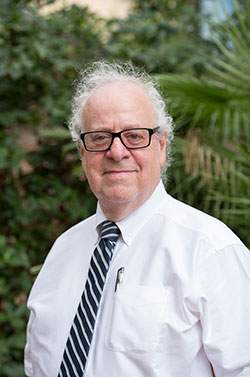New research indicates major effect COVID-19 has had on crime
Jayme Blaschke | August 14, 2020

The COVID-19 pandemic has impacted the United States in unprecedented ways, including significant declines in the crime rate. New research, conducted in part by Marcus Felson, professor in the School of Criminal Justice and Criminology at Texas State University, indicates that data may afford researchers the opportunity to reexamine crime theory, because government stay-at-home orders produced a natural experiment. In addition, re-opening bars and nightclubs produces a second experiment.
Felson's research is published in two papers. "Crime Rates in a Pandemic: the Largest Criminological Experiment in History," co-authored with Ben Stickle of Middle Tennessee State University, is published in the American Journal of Criminal Justice (https://link.springer.com/article/10.1007/s12103-020-09546-0). "Routine activity effects of the Covid-19 pandemic on burglary in Detroit, March, 2020," co-authored with Shanhe Jiang of Wayne State University and Yanquing Xu or the University of Toledo, is published in the journal Crime Science (https://crimesciencejournal.biomedcentral.com/articles/10.1186/s40163-020-00120-x).
"The initial lockdown period greatly reduced several types of crime in many places," Felson said.
The reason for the decline is that stay-at-home orders shift the routine activities of entire populations. Because these orders impacted countries, states and communities at different times and in different ways, a natural experiment unfolded, testing criminological theories as never before.
However, those declines depended on crime type and may differ by parts of a city and land uses. For example, domestic violence began to increase while barroom violence decreased with the closing of entertainment districts.
Routine activity theory holds that criminal activity can be interpreted in terms of exposure to risk, that is, crime is most likely to occur when potential offenders converge in space and time with suitable targets in the absence of guardians—ordinary citizens whose presence discourages crime. For example, when youths gather near businesses whose owners and customers are absent, those businesses become targets of opportunity. COVID-19 shifted routine activities by moving owners and customers away from business locations, leaving them highly vulnerable to burglary and trespassing. Conversely, residential burglaries declined during that same period, presumably due to the fact that residents were home more often due to government orders. Felson explained that crime levels started to return to "normal" after traditional entertainment patterns began to resume and stay-at-home routines began to erode.
Felson said he hoped other researchers would take the opportunity to study specific types of crime following the stay-at-home orders. The results could potentially reveal not only why, where, when and to what extent crime changed, but also how to influence future crime reduction.
Share this article
For more information, contact University Communications:Jayme Blaschke, 512-245-2555 Sandy Pantlik, 512-245-2922 |